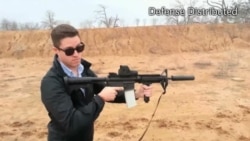AUSTIN, TEXAS —
As lawmakers seek to curb gun violence in the United States, they may need to address technological advances in how firearms can be made. In recent years, there has been a great increase in the use of 3-D printers that produce plastic forms, including gun parts. Some political activists are promoting homemade firearms as a way around legal constraints.
Cody Wilson thinks everyone should be able to own semi-automatic weapons like the one he has.
"For me it is a demonstration of radical equality," he said. "Anything that law enforcement and the military can have I believe an individual person should be able to have. It is a simple demonstration of individual sovereignty."
This self-described anarchist made his rifle from designs found online and used a 3-D printer to produce some of the parts in hard plastic.
"If the piece is designed well in the software, all you have to do is click 'print' and it is created for you in the machine," Wilson explained.
As lawmakers try to limit the capacity of ammunition clips, Wilson makes his own.
"They want to ban anything that accepts more than 10 rounds, and if it is New York state, seven rounds. All right, if I tell you I can print this, it completely pierces any ban," he said.
But the firing chamber and barrel of this rifle still need to be made of metal. And while an individual can legally make one, federal law prohibits the sale of such homemade guns.
Security analyst Fred Burton at Austin-based Stratfor, a private global intelligence organization, thinks printable guns are not a big threat at present.
"It would be extraordinarily difficult to create a firearm like this that is 100 percent plastic, just because of the force of the round going down the muzzle," he explained.
But Burton says it still represents a challenge to law enforcement.
"It may only work in a limited capacity, to some degree, but it still could be used to circumvent certain kinds of federal firearms laws," he said.
At the University of Texas, law professor Sanford Levinson shares that concern.
"The obvious question is whether this can and should be outlawed," he said.
But since 3-D printers are used widely in manufacturing, Levinson says lawmakers could have a hard time imposing adequate regulations.
"Technology may be far outrunning our practical ability to control the use that is made of it," he said.
But Levinson says lawmakers can and should try to control guns because maintaining security is one of government's most fundamental responsibilities.
Surveys show that only a small minority of people in the United States think they need guns to protect themselves from the government. And even most gun owners favor some legal restrictions on firearms.
Cody Wilson thinks everyone should be able to own semi-automatic weapons like the one he has.
"For me it is a demonstration of radical equality," he said. "Anything that law enforcement and the military can have I believe an individual person should be able to have. It is a simple demonstration of individual sovereignty."
This self-described anarchist made his rifle from designs found online and used a 3-D printer to produce some of the parts in hard plastic.
"If the piece is designed well in the software, all you have to do is click 'print' and it is created for you in the machine," Wilson explained.
As lawmakers try to limit the capacity of ammunition clips, Wilson makes his own.
"They want to ban anything that accepts more than 10 rounds, and if it is New York state, seven rounds. All right, if I tell you I can print this, it completely pierces any ban," he said.
But the firing chamber and barrel of this rifle still need to be made of metal. And while an individual can legally make one, federal law prohibits the sale of such homemade guns.
Security analyst Fred Burton at Austin-based Stratfor, a private global intelligence organization, thinks printable guns are not a big threat at present.
"It would be extraordinarily difficult to create a firearm like this that is 100 percent plastic, just because of the force of the round going down the muzzle," he explained.
But Burton says it still represents a challenge to law enforcement.
"It may only work in a limited capacity, to some degree, but it still could be used to circumvent certain kinds of federal firearms laws," he said.
At the University of Texas, law professor Sanford Levinson shares that concern.
"The obvious question is whether this can and should be outlawed," he said.
But since 3-D printers are used widely in manufacturing, Levinson says lawmakers could have a hard time imposing adequate regulations.
"Technology may be far outrunning our practical ability to control the use that is made of it," he said.
But Levinson says lawmakers can and should try to control guns because maintaining security is one of government's most fundamental responsibilities.
Surveys show that only a small minority of people in the United States think they need guns to protect themselves from the government. And even most gun owners favor some legal restrictions on firearms.









